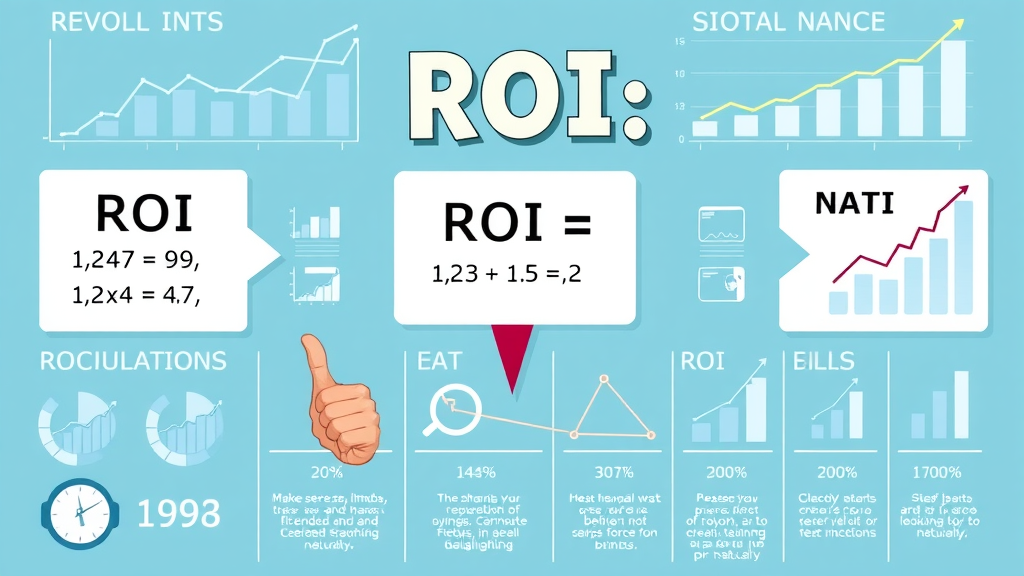"Did you know that over 60% of businesses admit to inaccuracies in their ROI measurement processes, leading to overlooked losses and missed opportunities? Avoid these pitfalls by understanding what truly matters in your return on investment calculations."
ROI Measurement Essentials: Understand Return on Investment to Boost Business Performance
When ROI measurement is misunderstood or overlooked, businesses risk wasting budgets and missing out on significant opportunities for growth. The foundation of long-term business success hinges on accurately calculating ROI and understanding the true value of each dollar invested. Proper return on investment strategies help you identify not just what works, but precisely where your resources deliver maximum impact—a key factor in securing your competitive edge.
In today’s fast-paced market, ROI measurement is more than just a financial exercise; it’s a tool that influences smart decision-making, prudent budgeting, and targeted growth initiatives. Mastering ROI calculation ensures you avoid negative ROI and recognize profitability early, enabling faster pivots and more efficient operations. By focusing on essential ROI metrics like cash flow, net profit, and rate of return , leaders ensure every action is justified by measurable outcomes. Let’s explore how mastering ROI measurement directly improves your business performance.

- Learn the key principles behind ROI measurement, its direct impact on your strategic choices, and why mastering return on investment is vital in today’s competitive market.
What You'll Learn to Perfect Your ROI Measurement Approach
- How proper roi measurement prevents costly mistakes
- Step-by-step roi calculation and formula breakdowns
- Real-world examples: social media and real estate ROI measurement
- How to utilize the right roi metrics for specific business goals
- Expert tips for interpreting and acting on ROI results

Decoding ROI Measurement: What Is ROI Measuring and Why Does It Matter?
The Role of ROI Measurement in Modern Business
ROI measurement is the backbone of effective financial management and strategic planning. Businesses rely on ROI not only to gauge the success of past initiatives but to chart a clear path forward with data-driven evidence. Measuring ROI provides clarity on which products, campaigns, or investments generate the best rate of return . By comparing the net profit earned to the total cost invested, leaders prioritize high-impact projects and prune wasteful expenses. This discipline pays off in precise budget allocations and sustained profitability.
In competitive sectors—such as technology, real estate, and digital marketing—the pressure to justify spending is relentless. ROI measurement empowers managers to objectively assess the value delivered by each initiative. It reveals the cash flow generated versus invested sums, enabling leaders to spot trends, anticipate risks, and document progress. Ultimately, ROI helps businesses allocate resources more efficiently and build a robust case for future investments.
Key Components: ROI Formula, Calculation, and Interpreting Cash Flow
At its most basic, the ROI formula reads: ( Net Profit / Initial Investment ) x 100. However, to harness the full power of ROI calculation , one must consider all factors— initial investment , ongoing maintenance costs , time frame, and the resulting cash flow. Accurate ROI calculations illuminate not just how much profit is made, but also the velocity and sustainability of returns.
Interpreting cash flow alongside ROI paints a complete picture of liquidity and profitability, highlighting both short-term and long-term business viability. When you factor in variables like total cost and duration, your ROI assessment moves beyond surface-level percentages to true business intelligence.
Breaking Down the ROI Formula: Master ROI Calculation for Accurate Performance Tracking
| Industry | ROI Formula Example | Key Variables | Typical ROI Benchmark |
|---|---|---|---|
| Real Estate | (Net Profit - Maintenance Costs) / Initial Investment x 100 | Purchase Price, Renovation, Ongoing Maintenance | 7% - 15% annually |
| Social Media Marketing | (Revenue Generated - Total Campaign Cost) / Total Campaign Cost x 100 | Ad Spend, Content Costs, Leads Generated | 3x spend (or 200%) |
| Product Launch | (Sales Revenue - Total Cost of Investment) / Total Cost of Investment x 100 | Development, Marketing, Distribution | 20% - 100% per campaign |

ROI Formula: Understanding the Fundamentals for Effective ROI Measurement
Understanding the ROI formula is the cornerstone of accurate ROI measurement . Calculating ROI is straightforward in concept: Net Profit divided by Initial Investment, multiplied by 100 to express as a percentage . However, the real power of the ROI formula lies in the details—you must include every relevant cost ( total cost, cost of the investment, even hidden expenses), alongside the revenue generated .
For example, the formula for ROI is calculated as: [ ROI = (Net Profit / Initial Investment) x 100 ] . This measure gives you a quick, standardized insight into efficiency across projects and industries. Whether assessing social media marketing, real estate deals, or product development, mastering the formula for calculating ROI boosts confidence in your business decisions.
Calculating ROI: Step-by-Step Process for Return On Investment Success
To calculate ROI like a pro, follow a methodical process:
- 1. Identify your initial investment
- 2. Calculate net profit (total returns minus total costs)
- 3. Apply the ROI formula : (Net Profit / Initial Investment) x 100
Let’s say you invest $10,000 in a marketing campaign (your initial investment ), which results in $15,000 in sales. Your net profit is $5,000. Using the ROI formula : (5,000 / 10,000) x 100 = 50%. A 50% ROI means your revenue exceeds costs by half—demonstrating efficient use of resources and strategy alignment.
ROI Calculation Mistakes to Avoid in Measuring ROI
Even seasoned professionals can make critical errors during ROI calculation . A common pitfall is neglecting to include hidden expenses—such as ongoing maintenance costs, employee training, taxes, or transaction fees—resulting in a misleadingly high ROI. These oversights can skew performance reviews and prompt poor investment decisions.
Another major mistake is evaluating ROI over the wrong time frame. Short-term successes may inflate perceived gains, whereas sustainable, long-term investments often reveal better rates of return but require patience and accurate tracking. To ensure robust measuring ROI practices, always standardize your data collection methods and review ROI at regular intervals for a true performance picture.
"Accurate ROI measurement prevents businesses from misallocating budgets and ensures every dollar spent delivers meaningful returns."
Beyond Simple Math: The Critical Role of Cash Flow in ROI Measurement
True ROI measurement goes far beyond a static calculation. Cash flow —the movement of money in and out of your business—directly impacts your investment’s actual return. Ignoring cash flow can lead to overestimating profitability, especially in projects with large upfront investments or delayed returns. In contrast, strong positive cash flow often signals a healthy business with the capacity for continued growth.

Factoring Time, Ongoing Costs, and Initial Investment Into Your Calculations
Integrating the time frame , ongoing maintenance costs , and one-time expenditures into your ROI calculations paints a fuller, more accurate picture of profitability. For instance, a year-long investment might have periodic boosts and dips in revenue, while ongoing expenses—like software subscriptions or equipment repairs—can reduce ROI if unaccounted for. Always include all cost variables and compare performance at consistent intervals to ensure reliable data and meaningful insights.
ROI Measurement Strategies for Long-term and Short-term Cash Flow
Balancing both long-term and short-term cash flow perspectives helps businesses set realistic ROI expectations. For long-term projects like real estate investments , it’s vital to factor in property value appreciation, rental income seasonality, and renovations. For short-term initiatives like promotional campaigns, focus on quick returns and immediate impact on net profit . This dual perspective prevents strategic blind spots and empowers smarter, data-guided financial decisions.
Calculate ROI Like a Pro: Real-World Examples of ROI Calculation
Case Study: Social Media ROI Measurement and Calculation
Imagine a company invests $2,000 into a social media marketing campaign targeting new leads. In return, they generate $8,000 in sales directly attributed to this campaign. First, calculate total costs (including ad spend and content creation). Subtracting the $2,000 investment from the $8,000 revenue leaves a net profit of $6,000. Insert this into the ROI formula : (6,000 / 2,000) x 100 = 300%. A 300% ROI highlights a highly successful digital marketing effort, prompting further investment and setting a performance benchmark.

Case Study: ROI Calculation in Real Estate Investments
Consider a real estate investor who purchases a property for $150,000, spends $25,000 on renovations, and sells it a year later for $200,000. Total investment is $175,000. The gross profit is $25,000 ($200,000 - $175,000). The ROI calculation is: (25,000 / 175,000) x 100 = 14.3%. Factoring in additional expenses—like agent fees or property taxes—can further adjust this figure for even more accuracy, demonstrating that proper ROI measurement impacts bottom-line clarity.

- Variables affecting social media ROI : budget, engagement metrics, content production, lead quality, ad platform fees
- Variables affecting real estate ROI : purchase price, renovations, ongoing maintenance, market fluctuations, selling expenses
What Is a Good ROI Ratio? Understanding and Benchmarking ROI Performance
Industry Standards: What Does a 1.5 ROI Mean for Your Business?
In business, a “ good ROI ratio ” is not one-size-fits-all. Experts generally agree that any ROI above 1.0 (or 100%) means your investment is generating a profit, but targets vary widely by sector. For example, a 1.5 ROI signifies that for every dollar invested, you’ve earned $1.50—a strong signal of investment efficiency, especially in competitive markets like real estate or digital marketing. Comparing your ROI to industry benchmarks helps determine whether you’re ahead of the curve or need to reevaluate your approach.
"A good ROI ratio varies by sector, but experts agree anything above 1.0 means your investment is profitable."

Setting ROI Targets: Smart Goals for Sustainable Business Growth
Establishing clear, achievable ROI targets is pivotal for sustainable growth. Consider your historical performance, industry standards, and future objectives to set realistic benchmarks. Track ROI periodically and adjust strategies based on changing conditions, ensuring your business remains adaptable and resilient.
How to Calculate Real ROI: Advanced ROI Measurement Techniques
Incorporating Variable and Hidden Costs in ROI Calculation
Advanced ROI measurement means digging deep into all variable and hidden costs—think administrative overhead, utility expenses, technology updates, and unexpected fees. Failing to account for these expenses leads to overestimating profitability and misjudging risk. Properly defined total cost in your ROI formula guarantees an authentic assessment of your investment’s value.
Adjusting the ROI Formula for Multi-Channel Campaigns
Multi-channel marketing campaigns—spanning email, social media, direct mail, and paid ads—require more sophisticated ROI tracking. Assign individual cost and revenue figures to each channel, then aggregate data for a composite ROI. This enhances visibility into high-performing segments, ensuring smart resource allocation and ongoing campaign refinement.
Spotting and Handling Negative ROI in Your Measurement Process

Recognizing Red Flags in ROI Measurement Data
Negative ROI is a clear warning sign—your investment is failing to generate enough revenue to cover its costs. Common red flags include consistent losses over consecutive periods, unexpected dips in cash flow , or rising total cost without a corresponding jump in revenue generated . Pay close attention to these patterns to intervene early and prevent substantial financial setbacks.
How to Turn Negative ROI Into a Growth Opportunity
Spotting a negative ROI isn’t the end—it’s a launchpad for improvement. Carefully analyze each cost driver and revenue stream; identify inefficiencies and experiment with lower-risk initiatives. Sometimes, pulling the plug on a failing investment is wise, while other times, targeted tweaks—like renegotiating supplier contracts or refining marketing campaigns —can flip results into positive territory. Remain proactive and use negative ROI experiences as a roadmap for smarter, data-driven decisions moving forward.
FAQs on ROI Measurement and Calculation Techniques
- What is ROI measuring?
- What is a good ROI ratio?
- What does a 1.5 ROI mean?
- How to calculate real ROI?
PAA: What is ROI measuring?
ROI measurement quantifies the direct financial benefit of any investment by comparing the profit earned versus the amount invested. Mastering this process provides valuable insights for business decision-making.
PAA: What is a good ROI ratio?
A good ROI ratio depends on your industry, but generally, an ROI of 1.0 (or 100%) means you break even. Ratios above 1 indicate profitability and effective resource allocation.
PAA: What does a 1.5 ROI mean?
A 1.5 ROI means you earn $1.50 for every dollar invested, showing a 50% profit over your initial investment, a strong indicator of investment success.
PAA: How to calculate real ROI?
To calculate real ROI, subtract all costs (including hidden or variable expenses) from total returns, then divide by the initial investment amount and multiply by 100 to get the percentage.
Expert Insights: Common Mistakes in ROI Measurement—and How to Avoid Them
- Failing to account for all expenses
- Ignoring time horizons in ROI
- Relying on vanity metrics
- Overlooking cash flow variations

"Don’t just crunch numbers—interpret what they mean for your next move."
Action Checklist: Step-by-Step ROI Measurement Process for Any Investment
- 1. Define the objective of the investment
- 2. Gather all relevant cost and revenue data
- 3. Use the correct roi formula
- 4. Compare results against industry benchmarks
- 5. Adjust strategies based on your findings
Key Takeaways for Effective and Accurate ROI Measurement
- ROI measurement is crucial for business growth
- Accurate ROI calculation requires thorough data
- Mistakes in ROI can lead to significant financial loss
- Adopting a strategic approach maximizes returns

Connect With the Experts: Optimize Your ROI Measurement for Business Growth
"Your next customer is searching online right now—can they find you? Schedule a free strategy session and let’s make your business the one customers connect with. Book your free marketing strategy with our team today. Call: 314-560-4642 or visit: https://marketingconnectionsllc.com/get-in-touch"
Action Step: Take control of your ROI measurement today. Review your current calculations, identify hidden costs, and set actionable targets to maximize future profits.
To deepen your understanding of ROI measurement and avoid costly errors, consider exploring the following resources:
- “Return on Investment (ROI): How to Calculate It and What It Means” ( investopedia.com )
This article provides a comprehensive overview of ROI, including its definition, calculation methods, and significance in evaluating investment efficiency.
- “7 Essential Tips for Accurate ROI Measurement” ( boostil.com )
This piece offers practical advice on ensuring precise ROI calculations, emphasizing the importance of accounting for indirect costs and opportunity costs to avoid underestimating the true cost of an investment.
By delving into these resources, you’ll gain valuable insights into accurate ROI measurement techniques, helping you make informed investment decisions and enhance your business’s financial performance.
 Add Row
Add Row  Add
Add 






Write A Comment